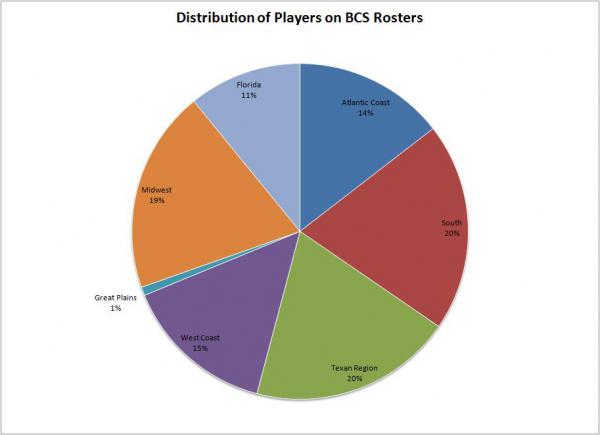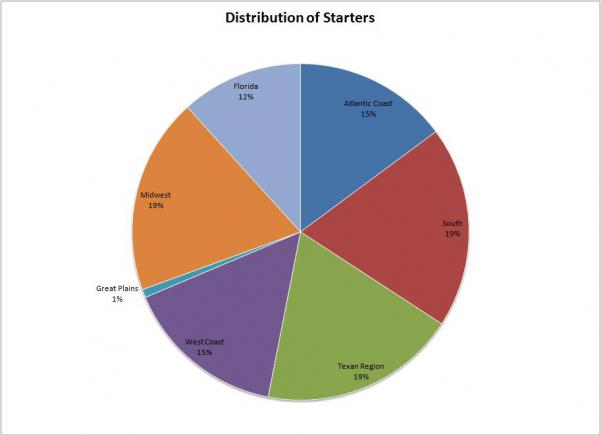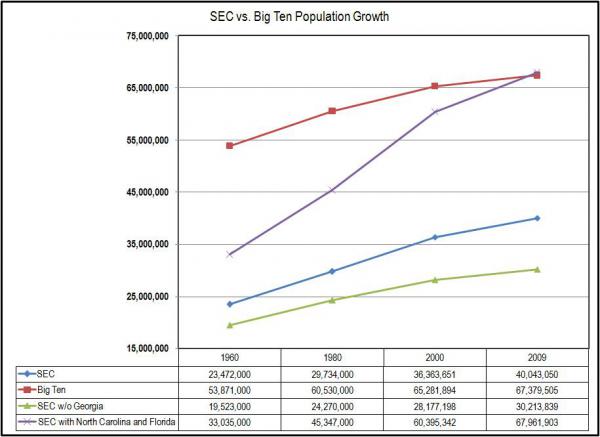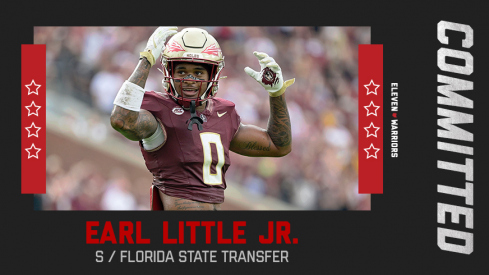Former Duke safety Terry Moore, a second-team All-ACC honoree in 2024, commits to Ohio State.

Six days out of a week, it's easy to keep perspective. Football is just football. They're not shooting unarmed protestors in Cairo or selling junk mortgages on Wall Street. Football is a way to escape from serious business and unashamedly root for the good guys, who we know are good because, dammit, they wear the right color red! They provide us with a generally harmless period of entertainment that, except for the occasional scandal, is left separate from the dirt that clings to us in our day jobs. So as the recruiting season and Superbowl officially fade away and the offseason truly begins, I have the opportunity to address those things that continue to bring in the grease and grime that I try to avoid. But first, a story:
Almost a thousand years ago in the hills of what is now eastern Turkey, the Byzantine Emperor Romanus IV Diogenes watched helplessly as the mightiest army in the known world melted away and his millennia-old empire cracked beneath his feat. His enemies, Seljuk horsemen, wore little more than street clothes and carried only a small sword and a shortbow, while the Roman soldiers were themselves the medieval equivalent of tanks; lifelong professionals that outfitted even their horses with heavy armor. Yet there were no finer horsemen than the Turks, and every time the Romans tried to force a fight the Great Seljuk Sultan and his light, swift horse-archers would fall back, peppering the enemy with arrows as they swatted vainly as at a swarm of wasps. Before the day had ended Emperor Diogenes was captured by the Sultan Arp Aslan, who punished the fallen Emperor by treating him as a brother; offering him a feast, his daughter's hand in marriage, and his freedom.
The Battle of Manzikert was one of those rare points in history where one event shook the entire foundations of the world. It didn't destroy the Empire. Indeed, Byzantium survived for almost 500 more years. Yet the eastern half of the Roman Empire, having already held on almost 600 years after the fall of the Rome, was reduced to a mere shell of its former glory. Before Manzikert, Constantinople was a shining beacon of Western civilization, the bearer of the heritage of the Caesars, and the wealthiest and most advanced civilization on the planet. After Manzikert, The Byzantines were petty Greek kings who the Lords in Europe and the Sultans in the Middle East viewed not with awe and respect, but hunger and greed. The Seljuk Turks later went on to conquer all of modern Turkey, lending it their name, before they themselves fell to the Mongols. Then, in the 13th Century, a Christian Crusader army sacked and pillaged the Byzantine capital rather than marching straight through to Jerusalem as promised, an act of treachery which ended any hope of survival. Finally, after 1,000 years continuous existence, the Ottomans conquered the city of Constantinople in 1453 and ended the last vestige of the once mighty realm.
Why should you care about a long dead Emperor of a long dead nation? What does any of this have to do with Ohio State? You see, that Emperor is us, my friends. We, fans of the Big Ten, shining beacon of civilization and upholder of all that is good and decent in amateur athletics, risk succumbing to that same sense of inevitable decline that afflicted so many great civilizations before us. So we should care, because if we don't, then no one else will. Allow me to explain.
In our post-Manzikert world, it seems barely a day passes without a new story discussing the many ways in which the Big Ten's best days are behind it; how it is a dinosaur among so many fleet-footed mammals. We all know it's bull**** because Ted Ginn Jr. runs so fast he warps time and space every time he picks up his mail and the Big Ten still wins plenty of football big games. Yet there's the issue. At the end of the day, it wasn't the battle that killed Byzantium, but the loss of respect. It doesn't matter whether you start the Big Ten Network, kick off college expansion, or play dominating basketball, because Ohio State's very own Manzikert makes sure the conference still suffers under the perception that Midwestern recruits simply aren't good athletes. Everywhere you hear the same self-defeating resignation: "The rest of the country is growing, and we're not. We just can't keep up. All of the best players come from the SEC." Andy Staples of Sports Illustrated even recently argued that a combination of dark skin, bar-b-que, and morbid obesity is why we're doomed to failure. Until the zietgeist moves on and Big Ten fans quit being so damn self-loathing, the perception that the Midwest is a talentless wasteland will slowly become a self-fulfilling truth as top talent moves to "greener" pastures elsewhere.
At the heart of this accusation lie two main arguments: The demographic argument and the racial argument. I've spent far more time than is healthy researching these claims, and I think it's safe to say that both are (mostly) complete garbage. I'm not deluded enough to think one blog post will have any effect on the prevailing attitudes, I think only winning will ultimately do that, but at least I'll be able to get this off my chest.
 Guess which one is the peanut butter part of the Buckeye?
Guess which one is the peanut butter part of the Buckeye?Argument 1: The Out of africa theory
I'll start with probably the most controversial argument: that black people are better at sports, for whatever reason, and since the south has more African-Americans, they have better football players. The more racist among the proponents of this theory usually argue that at some point slaves were selectively bred by owners to be better athletes. There are two big problems with this line of reasoning. 1) A better athlete is a better escapee. Only an idiot would make their slaves better at running away. 2) It's completely bogus. There's no evidence of slaves ever being forced to breed, and even if they were it would take centuries to make any real lasting genetic change. In the Andy Staples article I linked earlier, he puts forward a less racially charged version of this idea, but instead looks to Polynesia. With isolated populations like those living on a small island in the Pacific such widespread genetic changes are more likely, as is the case with the small group of Kenyan tribesman who are excellent distance runners. But in both cases we're talking about groups that number in the thousands who were isolated for extended periods of time, allowing recessive genes that might help in running or harpooning time to spread throughout the population. That didn't happen on Plantations.
Now, even if the "selective breeding" hypothesis were plausible, it would still amount to racism. To say "black people are better at sports" is to say that people who have certain amount of melanin production are more or less athletic. There's never been a link discovered between athleticism and either melanin count or the ability to grow a good afro, this I promise. Leaving aside the often unstated addendum, "and whites are smarter," if we move forward with the assumption that race is linked with athletic ability that also leaves unathletic black men and women in an awkward position, akin to a poor Asian-American kid getting bugged by college kids to help with math just because his parents are from China, or everyone assuming that the white guy in the room is an incredible dancer. Of course, this is all assuming it were even possible to define "black" in biologically meaningful manner to begin with.
The one caveat to all of this: according to most modern studies, all humans came originally from Africa somewhere in Ethiopia. As a result, scientists have found that any two random non-Africans(including African Americans) are almost certainly more genetically similar to each other than any two random native Africans are similar to each other. Since those humans that left Africa were only a small group of a much larger population that stayed on the continent, all humans from outside of the continent are essentially inbred compared to native Africans. The practical effect of this is that because there's so much more genetic diversity in Africa than outside of it, you're likely to find both the smartest and dumbest, fastest and slowest, strongest and weakest, tallest and shortest people in the world in Africa. For whatever that's worth.
Now, assuming all of this didn't matter, and it is 100% true that a larger African-American population equals a larger pool of great athletes, it's still not a good reason for why the SEC is supposedly more talented than everyone else. While it's true that the SEC states have the largest African-American high school population (~900,000) according to the census estimates, it's by a pretty slim margin over the ACC (~840,000), who haven't had to work very hard to find space for their football trophies lately. The conference with the fewest African-Americans? The Pac-10 (~220,000), followed by the Big XII (~250,000), then the Big Ten (~560,000), all of whom are far better conferences than the comparatively dark Big East (~750,000). So, the two "worst" BCS conferences and the "best" BCS conference all share this characteristic, while the Pac-10, Big Ten, and Big XII, three conference with multiple MNC appearances and victories to their credit, do not.
 Thomas Malthus thinks you're having too many babies, SEC.
Thomas Malthus thinks you're having too many babies, SEC. Argument 2: The demographic Argument
The second argument is one that's so common, people don't even bother to defend it anymore and it's simply assumed to be true. Hell, you've probably made it yourself. Fundamentally, it goes like so: "The South is where everyone's moving, the North is where everyone's leaving. It doesn't take a rocket scientist to see that this is shifting the talent south as well." While the first argument is not really much of an argument at all, at its core, this one contains an element of truth to it. It's absolutely true that the Midwest is growing more slowly than the rest of the country. In fact, over the last 10-years, the Midwest is estimated to have grown 3% while the rest of the country grew by an average of 10%. Case closed right? Why the hell am I even writing this? Maybe you should write it if you think you're so smart. Actually, the truth is that if you dig even a little deeper into the demographics, the story is quite different.
There are two ways to evaluate the demographic significance of the SEC relative to the Big Ten. First, you can look at comparative population growth in more detail, which I'll do in a bit. Second, and way more time consuming on my end, is to look at the rosters of every single BCS conference team and see where their talent is coming from. Now, this analysis entailed a bit of executive decision making on my part, as conferences overlap each other. So I decided that rather than organizing recruits by what conference their state is a part of (impossible with situations like PennSt-Pitt, Florida-FSU-Miami-USF, South Carolina-Clemson, Iowa-Iowa State, and Kentucky-Louisville), I'd grouped states regionally, mostly by sports culture, i.e. basketball states with basketball states, rabid SEC states with rabid SEC states, etc...
The end result is that regions are organized along conference lines with these notable exceptions: 1) I combined the ACC and Big East into one super region of all the Northeastern states plus Virginia and North Carolina as it's a basketball region and thus distinct from the rest of the south 2) I put all of the states that border Texas in their region, which includes New Mexico, since Texas is such a monolithic presence in the region. 2) I kept Florida separate from any conference, as its own distinct region since you can't credibly argue that UF is a bigger deal than both FSU and Miami and Florida is really different from the rest of the south culturally.
Now, fundamental Supply and Demand would suggest that an overabundance of talent in the south would mean that other conferences repeatedly raid the SEC's backyard to snatch prospects that don't want to wait 4 years behind all of the Southern Ubermensch ahead of them. So we would expect that southern recruits dominate the distribution. Surprisingly, recruits are pretty widely dispersed. Here's a chart of where every single player on a BCS team came from:

Roughly 60% of the players are divided equally between Texas, the Big Ten, and the South. As one would expect, the more football fanatic regions have more football recruits, but no one region dominates the BCS rosters. "But wait," you might say if you were paid by me to help me advance my argument, "It's not that the MOST players come from the South, but that the BEST players come from the South. I'll bet the South is more heavily represented on the starting rosters than on the rosters as a whole, what with walk-ons and communism." That's a great point, so I went ahead and just looked at the starting 22 for each BCS team, who would presumably be the 22 best players on the team. Here's the chart:

The south is actually worse off on the depth chart than on the roster as a whole. The ACC and Florida pick up a little while the South and Texas lose a little. Functionally, though, the differences are too minor to really matter. If broken down by conference, it proves to be incredibly regional. SEC teams recruit 80% of their kids from within their own conference, Big Ten teams over 75%, the Pac-10 80%, and so on. The exceptions are the Big East, which recruits heavily in Big Ten territory and Florida (mostly the work of Cincinnati and USF respectively) and the ACC which recruits Florida, Georgia, and South Carolina heavily, for similarly obvious reasons. Basically, kids stay home. That doesn't address the longer term question, however. Surely, if the South is growing 3 times as fast as the Midwest, even if they're not really ahead now, won't they be in the future?
The answer to that question is yes, they absolutely would be, if SEC teams were actually growing quickly. With the exception of Georgia, they're not. In every single case of high growth in the SEC, the state was shared with decent sized ACC team. In the case of South Carolina - Clemson and FSU/Miami - Florida, the ACC arguably has the bigger program(s). One last chart to illustrate this point: I
I
The Big Ten starts off in 1960 with a massive 30million person advantage over the SEC. By 2009, that advantage has shrunk to a measly 27million. Wait, huh? Yeah, over the span of 49 years the SEC has managed to make up exactly 10% of their population deficit with the Big Ten. I'll be sure to crap my pants when I'm 500 years old and the SEC finally passes the Big Ten in population. It's important to note that the while the south is still growing at a faster clip than the Big Ten, growth rates are leveling off. Even more interestingly, if you exclude those states the SEC shares with the ACC, the Big Ten actually grew more than the SEC, 13.5million to 10.7million. Maybe they'll make it up in volume.
The reason I have that other line showing the SEC + North Carolina and Florida is to illustrate the extent to which the "growth" in the SEC has actually been in just two, mostly ACC states. If you add those two states, the South is actually bigger than the North, mostly on the strength of North Carolina's growth over the last decade (where I currently live). Of course, North Carolina is not SEC country, so why its growth should matter is a mystery. As for Florida, they may actually be losing population now that the housing market is no longer artificially inflated, much like Nevada.
And?
And, so, while it's possible that adding 3 million people over 49 years was the thing that put the SEC over the edge, it seems pretty unlikely. If you want a good idea of what a demographically led creation of a football powerhouse actually looks like, look at Florida State and Miami in the 80s, USC in the 60s, Ohio State in the 40s, or Utah and TCU right now. That's not to say that the SEC's success has been a mirage or that the South doesn't put out more than its fair share of good players. My point is that the SEC's success, such that it is, doesn't come from some supposed weakness of the Big Ten. They're not bleeding our talent away, and black skin doesn't grant super powers (unfortunately).

